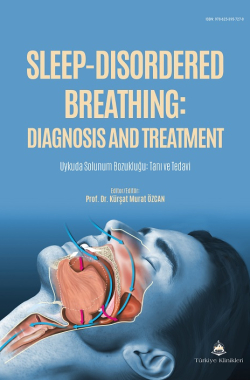TREATMENT OF PEDIATRIC OBSTRUCTIVE SLEEP APNEA
Mehmet Fatih Karakuş
Ordu University, Faculty of Medicine, Department of Otorhinolaryngology, Ordu, Türkiye
Karakuş MF. Treatment of Pediatric Obstructive Sleep Apnea. In: Özcan KM, editor. Sleep-Disordered Breathing: Diagnosis and Treatment. 1st ed. Ankara: Türkiye Klinikleri; 2025. p.205-211.
ABSTRACT
During routine medical consultations for children who appear healthy, clinicians should inquire about sleep duration and quality, snoring, frequent nighttime awakenings, unusual sleep positions, and disturbances in bed linen, as these elements are essential in identifying pediatric obstructive sleep apnea syndrome. Intrinsic and extrinsic anatomical, genetic, or neuromuscular abnormalities that impair the expansion-collapse dynamics of the upper airway each contribute to the development of obstructive sleep apnea syndrome. Although history and physical examination are key components, overnight polysomnography remains the gold standard for diagnosis in pediatric population. An apnea-hypopnea index of 1-5 is classified as mild, 5-10 as moderate, and greater than 10 as severe obstructive sleep apnea syndrome in children. Undiagnosed and untreated pediatric obstructive sleep apnea syndrome may lead to significant long-term complications. In pediatric obstructive sleep apnea patients, both the severity of the disease and the patient’s age must be taken into account when determining the optimal treatment modality -either surgical or non-surgicaland the treatment plan should be tailored according to a thorough, case-bycase analysis. Treatment option should be selected collaboratively with the family, guided by a multidisciplinary team comprising a pediatrician, otorhinolaryngologist, pulmonologist, child psychiatrist, orthodontist, cardiologist, maxillofacial surgeon, and anesthesiologist. Surgical management frequently include adenotonsillectomy in cases of adenotonsillar hypertrophy. Corrective procedures for craniofacial anomalies may be performed in children under two years of age. Non-surgical management options, generally suitable for mild to moderate obstructive sleep apnea, focus on treating controllable factors like obesity, and include pharmacological agents such as leukotriene receptor antagonists and corticosteroids may be used. Continuous positive airway pressure (CPAP) therapy is indicated when surgery is not feasible or if moderate to severe obstructive sleep apnea persists postoperatively. Additionally, intraoral appliances and myofunctional therapy may be useful in a selected group of well-defined cases. In conclusion, it should be emphasized that each undiagnosed and untreated case of pediatric obstructive sleep apnea carries significant health risks at both the patient and society. It must be remembered that the foundation of a healthy society lies in the physical and mental well-being of its individuals themselves.
Keywords: Sleep apnea, obstructive; Child; Tonsillectomy; Mouth; Myofunctional therapy
Kaynak Göster
Referanslar
- Garg RK, Afifi AM, Garland CB, Sanchez R, Mount DL. Pediatric Obstructive Sleep Apnea: Consensus, Controversy, and Craniofacial Considerations. Plast Reconstr Surg. 2017;140(5):987-997. [Crossref]
- Li Z, Celestin J, Lockey RF. Pediatric Sleep Apnea Syndrome: An Update. J Allergy Clin Immunol Pract. 2016;4(5):852861. [Crossref] [PubMed]
- ElMallah M, Bailey E, Trivedi M, Kremer T, Rhein LM. Pediatric Obstructive Sleep Apnea in High-Risk Populations: Clinical Implications. Pediatr Ann. 2017;46(9):e336-e339. 01. Erratum in: Pediatr Ann. 2017;46(11):e436. [PubMed]
- Gouthro K, Slowik JM. Pediatric Obstructive Sleep Apnea. [Updated 2023 May 1]. In: StatPearls [Internet]. Treasure Island (FL): StatPearls Publishing; 2025 Jan-. [Crossref]
- Schwengel DA, Dalesio NM, Stierer TL. Pediatric obstructive sleep apnea. Anesthesiol Clin. 2014;32(1):237-261. [PubMed]
- Mussi N, Forestiero R, Zambelli G, Rossi L, Caramia MR, Fainardi V, et al. The First-Line Approach in Children with Obstructive Sleep Apnea Syndrome (OSA). J Clin Med. 2023;12(22):7092. [Crossref] [PubMed] [PMC]
- Lumeng JC, Chervin RD. Epidemiology of pediatric obstructive sleep apnea. Proc Am Thorac Soc. 2008;5(2):242-252. [Crossref] [PubMed]
- Kar M, Altıntoprak N, Muluk NB, Ulusoy S, Bafaqeeh SA, Cingi C. Antileukotrienes in adenotonsillar hypertrophy: a review of the literature. Eur Arch Otorhinolaryngol. 2016;273(12):4111-4117. [Crossref] [PubMed]
- Sakarya EU, Bayar Muluk N, Sakalar EG, Senturk M, Aricigil M, Bafaqeeh SA, et al. Use of intranasal corticosteroids in adenotonsillar hypertrophy. J Laryngol Otol. 2017;131(5):384-390. [Crossref] [PubMed]
- Jazi SM, Barati B, Kheradmand A. Treatment of adenotonsillar hypertrophy: A prospective randomized trial comparing azithromycin vs. fluticasone. J Res Med Sci. 2011;16(12):1590-1597. [PubMed] [PMC]
- Tran-Minh D, Phi-Thi-Quynh A, Nguyen-Dinh P, DuongQuy S. Efficacy of obstructive sleep apnea treatment by antileukotriene receptor and surgery therapy in children with adenotonsillar hypertrophy: A descriptive and cohort study. Front Neurol. 2022;13:1008310. [Crossref] [PubMed] [PMC]
- Ng SK, Lee DL, Li AM, Wing YK, Tong MC. Reproducibility of clinical grading of tonsillar size. Arch Otolaryngol Head Neck Surg. 2010;136(2):159-162. [Crossref] [PubMed]
- Dayyat E, Kheirandish-Gozal L, Sans Capdevila O, Maarafeya MMA, Gozal D. Obstructive sleep apnea in children: relative contributions of body mass index and adenotonsillar hypertrophy. Chest. 2009;136(1):137-144. [Crossref] [PubMed] [PMC]
- Lam YY, Chan EY, Ng DK, Chan CH, Cheung JM, Leung SY, et al. The correlation among obesity, apnea-hypopnea index, and tonsil size in children. Chest. 2006;130(6):17511756. [Crossref] [PubMed]
- Lee CH, Hsu WC, Chang WH, Lin MT, Kang KT. Polysomnographic findings after adenotonsillectomy for obstructive sleep apnoea in obese and non-obese children: a systematic review and meta-analysis. Clin Otolaryngol. 2016;41(5):498-510. [Crossref] [PubMed]
- Bhattacharjee R, Kheirandish-Gozal L, Spruyt K, Mitchell RB, Promchiarak J, Simakajornboon N, et al. Adenotonsillectomy outcomes in treatment of obstructive sleep apnea in children: a multicenter retrospective study. Am J Respir Crit Care Med. 2010;182(5):676-683. [Crossref] [PubMed]
- Cielo CM, Gungor A. Treatment Options for Pediatric Obstructive Sleep Apnea. Curr Probl Pediatr Adolesc Health Care. 2016;46(1):27-33. [Crossref] [PubMed]
- Goldbart AD, Greenberg-Dotan S, Tal A. Montelukast for children with obstructive sleep apnea: a double-blind, placebo-controlled study. Pediatrics. 2012;130(3):e575-80. [Crossref] [PubMed]
- Chuang LC, Hwang YJ, Lian YC, Hervy-Auboiron M, Pirelli P, Huang YS, et al. Changes in craniofacial and airway morphology as well as quality of life after passive myofunctional therapy in children with obstructive sleep apnea: a comparative cohort study. Sleep Breath. 2019;23(4):1359-1369. [Crossref] [PubMed]
- Hwang YJ, Huang YS, Lian YC, Lee YH, Hervy-Auboiron M, Li CH, et al. Craniofacial Morphologic Predictors for Passive Myofunctional Therapy of Pediatric Obstructive Sleep Apnea Using an Oral Appliance with a Tongue Bead. Children (Basel). 2022;9(7):1073. [Crossref] [PubMed] [PMC]

